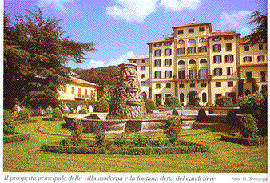Villa Torlonia
|
Villa Torlonia |
||
 |
||||
|
In the imposing gate overlooking the present Piazza Marconi allows access to the main boulevard of the Villa which was flanked in the early XXth century, by a double row of trees. On the left side, there were four flight of steps in spur stone leading to the gardens of the Villa, on the right side, there was a point offering a splendid view ofRome and of the Roman countryside, extendingftom the sea to the first spurs of the Apennines. Walking down the boulevard, one can see, on the left a fountain with an inscription referring to the works that Duke Salvatore Sforza Cesarini carried out, in 1826, to improve the canalisation of the waters in the area. |
||||
|
At the end of the boulevard is a semicircular courtyard with a splendid fountain at the centre, known as "Il Candeliere" (the Candlestick) due to its particular shape, which stands on a base enclosing another magniflcent fountain with three niches. On the opposite side is the Palace, built on the site of the old Villa, which was almost completely destroyed on September 8, 1943, when Frascati was bombed. In the middie between the first and the second level of the Villa, at the crossing of two boulevards, there is a fountain with the Eagle of the Conti family, supporting a bas in which collects the waters coming out from a mask, before falling down into a bigger basin used as a base for the whole work ofart. On the second level of the Villa is a small fountain with the name of cardinal Galli sculpted on it. Beyond the gardens is the magnificent Theatre of the Waters used, during the 50s, for a show of lights and sounds (the opening took piace on September 23, 1958 with the show of the "Magic Nocturne" before mayor Pietro Micara, the President of the Council of Ministers, Amintore Fanfani, the Ministers Tambroni and Togni and the American and Russian ambassadors). Finally, on the last level of the Villa, in a small thicket is another big circular basin collecting the waters which feed the underneath theatre. The land the Villa was built on, belonged to the Abbey of Grottaferrata which donated it, in 1563, to Annibal Caro who commissioned to build a srnall Villa ("the Caravilla") where he spent the last years of his life, while translating the Aeneid. In 1896, Prince Leopoldo Torlonia put a memorial stone just to remember this event. In 1671, Beatrice Cenci bought the Villa which was passed in 1596 to Cardinal Tolomeo Galli, bishop of the Tuscolane area from 1591 to 1600 and Secretary of State under Gregory XIII who commissioned the flrst enlargement works. In 1607, Cardinal Scipione Borghese, Paul V's nephew, took possession of the Villa; he enlarged and embellished the Villa. The waterworks used to feed the fountains of the Villa and the spectacular Theatre of the Waters dates back to that period (the works were carried out by Giovanni Fontana).Other owner were Stefano Colonna, Conti family, Sforza Cesarini family. During The second war on September 8, it was seriously damaged |
||
|
|
|||